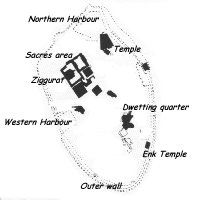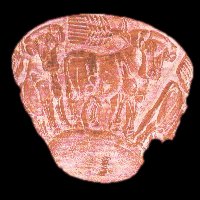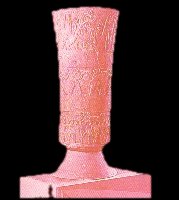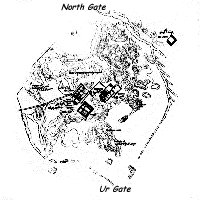The dawn of urban civilization:
- Excavations have proved that Ur was leading among the old Sumeria cities of Mesopotamia. Its earliest dwellings go back some six-thousand years, and after it had enjoyed prominence in the dawn of dynasties, 4800 - 4300 years ago, it assumed a leading position during the Third Dynasty of Ur, over 4000 years ago.
In later times, although political leadership shifted to other Babylonian and Assyrian centers, it maintained its importance and kings continued to lavish their care on its temples and institutions.
The landmarks of the city lie within a large area the inhabited section of which measured 1200 x 700 meters. It was encircled by a mud-brick wall, almost elliptical in shape.
 |
The favourit god of Ur was SIN, or NANNAR, the moon-god, His ground temple was built near the Ziggurat.
Another prominent building was the palace of king Shulgi, son of Ur-Nammu, sitauted in the southern corner of the sacred area. Of a square plan 55 x 55 meters, it used to be called the Mountain House.
To the east of the temple area is a huge pit which was a vast cemetery dating back to the thrid dawn of dynasties, 4500 years ago. It contained about two-thousand graves which have yielded a veritable treasure of rare objects that have enriched the display halls of many museums, such as the Iraqi Museum, The Nasiriya Museum, The British Museum, Pennsylania Museum, etc.
These objects range from musical instruments (e.g.the "lyre of Ur") to gold and silver ornaments and precious jewellery. Next to it is the cemetery of the Kings and Princes of the Thrid Dynasty of Ur.
Its special feature is its sloping roofs. Not far away one can roam at leisure in a once-inhabited quarter that dates back to the old Babylonian era.
 |
 |
Uruk (Warka):
One of the most famous Sumerian citites of ancient Iraq. It was continuously inhabited from about 4000 B.C. up to the 5th century A.D. Because of the part it played in Iraqi culture for such a long time, one may want to spend some time among its ruins.
Uruk lies about 30 kms to the east of Samawa (see Iraq map), and in the past it used to be on the river Euphrates before it changed its course so much that it is nearly 12 kms away. It was an important city on two scores: religion and science, which is confirmed by the thousands of clay tablets dug in it which go back to the beginnings of writing - about 5000 years ago - in the invention of which Uruk played a major role. It was also the centre of the worship of the goddess Inanna, or Ishtar, which is symbolized by the star Venus. Her worship went to the Greeks and Romans under the name of Aphrodite or Venus, who had exactly the same attributes as Ishtar.
Uruk was renowned for its walls which cuneiform texts say were first built 4700 years ago by the Sumerian King Gilgamesh, (see Relevent links)
hero of the epic named after him. The city limits and traces of its round walls are visible today. The latter are about 9.5 kms long.
Among major remains in the ziggurat of Inanna - Ishtar which rises to a height of 16 meters on a square base measuring 60x60 meters. It dates back to the time of Ur - Nammu, 4000 years ago. In its neighbourhood are the ruins of a temple which used for mural ornamentation thousands of coloured clay cones. Another temple in ruins is the one devoted to Anu, god of the sky, built with mud brick some 5000 years ago. Nearby is another temple devoted to Anu and his wife Anu - Antim, but it is a comparatively recent structure: it was built in Seleucid times, about 2.200 years ago. An even more recent structure is the brick temple whose facade is ornamented with arches and columns, together with decorative brickwork of animals and geometrical patterns. It was built around A.D. 110.
 |
 |
 |
 |
Please note;
Views best with dissoulution 600 x 800 with 256 colors. This page was accomplished by MS-Explorer (3.0), other browser may not handle the pages elements properly. The music used are standard MID, and WAVE sound. The photos are GIF, and JPG standard.